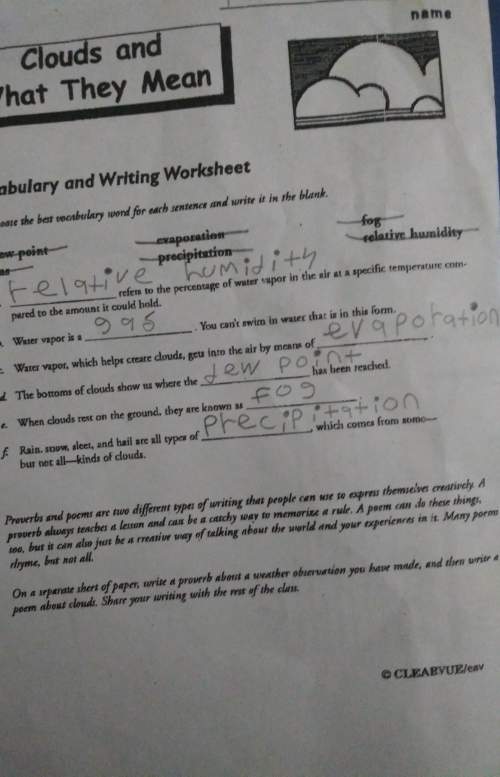
Physics, 06.02.2021 01:00 makeithappen60
Another class received similar data to what we saw yesterday. Their investigation found that it looks like water enters a plant through the roots and exits through the leaves when light shines on it. Below are three students’ claims to answer the question “what happens to the water inside the plant?”
They have collected the same evidence as our class. Using the things we have done in class so far, provide written feedback to each student. Your feedback should identify what evidence could be used to support their claim. How does the evidence you have in your Thinking Deeper Documents, support (or not support) their claims? Think of ALL the things we’ve done so far in this unit and ALL of the videos we’ve seen.
Student A: The same water molecules that come into the plant through the roots go out of the plant through the leaves. They just flow through the plant without changing.
What evidence supports students A’s claim?
Do you agree or disagree with student A? Why or why not?
Student B: The water molecules that go into the plant are used to make food molecules, and other chemical reactions in the plant form water molecules that come out of the leaves.
What evidence supports students B’s claim?
Do you agree or disagree with student B? Why or why not?

Answers: 1


Other questions on the subject: Physics

Physics, 21.06.2019 17:20, gymer630
American eels (anguilla rostrata) are freshwater fish with long, slender bodies that we can treat as uniform cylinders 1.0 m long and 10 cm in diameter. an eel compensates for its small jaw and teeth by holding onto prey with its mouth and then rapidly spinning its body around its long axis to tear off a piece of flesh. eels have been recorded to spin at up to 14 revolutions per second when feeding in this way. although this feeding method is costly in terms of energy, it allows the eel to feed on larger prey than it otherwise could. 1.a field researcher uses the slow-motion feature on her phones camera to shoot a video of an eel spinning at its maximum rate. the camera records at 120 frames per second. through what angle does the eel rotate from one frame to the next? 2. the eel is observed to spin at 14 spins per second clockwise, and 10 seconds later it is observed to spin at 8 spins per second counterclockwise. what is the magnitude of the eels average angular acceleration during this time? 3. the eel has a certain amount of rotational kinetic energy when spinning at 14 spins per second. if it swam in a straight line instead, about how fast would the eel have to swim to have the same amount of kinetic energy as when it is spinning? 4.a new species of eel is found to have the same mass but one-quarter the length and twice the diameter of the american eel. how does its moment of inertia for spinning around its long axis compare to that of the american eel?
Answers: 1


Physics, 22.06.2019 03:00, ambercuevas2707
An internally reversible refrigerator has a modified coefficient of performance accounting for realistic heat transfer processes of where qin is the refrigerator cooling rate, qout is the heat rejection rate, and is the power input. show that copm can be expressed in terms of the reservoir temperatures tc and th, the cold and hot thermal resistances rt, c and rt, h, and qin, as where rtot rt, c rt, h. also, show that the power input may be expressed as 1.39 a household refrigerator operates with cold- and hot-temperature reservoirs of tc 5 c and th 25 c, respectively. when new, the cold and hot side resistances are rc, n 0.05 k/w and rh, n 0.04 k/w, respectively. over time, dust accumulates on the refrigerator’s condenser coil, which is located behind the refrigerator, increasing the hot side resistance to rh, d 0.1 k/w. it is desired to have a refrigerator cooling rate of qin 750 w. using the results of problem 1.38, determine the modified coefficient of performance and the required power input w under (a) clean and (b) dusty coil conditions. internally reversible refrigerator qout qin w high-temperature reservoir low-temperature reservoir th th, i tc, i tc high-temperature side resistance low-temperature side resistance w qin th tc qinrtot tc qinrtot copm tc qinrtot th tc
Answers: 2

Physics, 22.06.2019 08:30, lovebunfan
What is the primary force that suspension bridges use cables to hold their spans up? a. tension force b. resistance force c. normal force d. elastic force e. applied force
Answers: 3
You know the right answer?
Another class received similar data to what we saw yesterday. Their investigation found that it look...
Questions in other subjects:



Chemistry, 25.04.2020 20:50

Mathematics, 25.04.2020 20:50

Social Studies, 25.04.2020 20:50

Mathematics, 25.04.2020 20:50


Social Studies, 25.04.2020 20:50


Medicine, 25.04.2020 20:50




